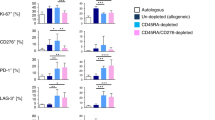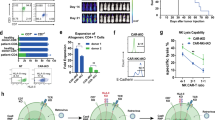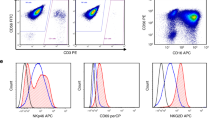Abstract
Refractory or relapsed acute myeloid leukemia (AML) represents a frequent complication after allogeneic hematopoietic stem-cell transplantation (HSCT). We show herein that primary in vitro stimulation of CD45RA-selected CD4 T cells of stem-cell donors with 10/10 HLA-matched AML blasts results in expansion of cytolytic T-lymphocytes (CTL) that almost all recognize HLA-DPB1 mismatch alleles, which clinically occur in up to 80% of donor-patient pairs. Primary AML blasts were found to strongly express HLA-DPB1, whereas fibroblasts and keratinocytes used as surrogate target cells for graft-versus-host disease did express HLA-DPB1 only upon IFN-γ pre-treatment. Since patients’ AML blasts are rarely available in clinical routine, we developed a protocol based on stimulation of donor-derived CD45RA-selected CD4 T cells with autologous dendritic cells electroporated with RNA encoding patients’ HLA-DPB1 mismatch alleles. Short-term stimulated T cell-lines specifically lysed HLA-DPB1 mismatch-expressing AML blasts, but not fibroblasts and keratinocytes without IFN-γ pre-treatment. Notably, these CD4 CTL efficiently eliminated AML blasts upon adoptive transfer into leukemia-engrafted NSG mice. In conclusion, we show strong immunogenicity of HLA-DPB1 mismatch alleles in CD45RA-selected CD4 T cells of stem-cell donors and introduce a novel strategy to reliably generate HLA-DPB1-specific CD4 CTL that might be powerful cellular therapeutics in relapsed or refractory AML after HSCT.
This is a preview of subscription content, access via your institution
Access options
Subscribe to this journal
Receive 12 print issues and online access
$259.00 per year
only $21.58 per issue
Buy this article
- Purchase on Springer Link
- Instant access to full article PDF
Prices may be subject to local taxes which are calculated during checkout






Similar content being viewed by others
References
Kolb H, Schmid C, Barrett AJ, Schendel DJ . Graft-versus-leukemia reactions in allogeneic chimeras. Blood 2004; 103: 767–776.
Falkenburg JH, Heslop HE, Barrett AJ . T cell therapy in allogeneic stem cell transplantation. Biol Blood Marrow Transplant 2008; 14: 136–141.
Kolb HJ, Schattenberg A, Goldman JM, Hertenstein B, Jacobsen N, Arcese W et al. Graft-versus-leukemia effect of donor lymphocyte transfusions in marrow grafted patients. Blood 1995; 86: 2041–2050.
Porter DL, Collins RH, Hardy C, Kernan NA, Drobyski WR, Giralt S et al. Treatment of relapsed leukemia after unrelated donor marrow transplantation with unrelated donor leukocyte infusions. Blood 2000; 95: 1214–1221.
Ferrara JL, Levine JE, Reddy P, Holler E . Graft-versus-host disease. Lancet 2009; 373: 1550–1561.
O'Reilly RJ, Dao T, Koehne G, Scheinberg D, Doubrovina E . Adoptive transfer of unselected or leukemia-reactive T-cells in the treatment of relapse following allogeneic hematopoietic cell transplantation. Semin Immunol 2010; 22: 162–172.
Warren EH, Fujii N, Akatsuka Y, Chaney CN, Mito JK, Loeb KR et al. Therapy of relapsed leukemia after allogeneic hematopoietic cell transplantation with T cells specific for minor histocompatibility antigens. Blood 2010; 115: 3869–3878.
Meij P, Jedema I, van der Hoorn MA, Bongaerts R, Cox L, Wafelman AR et al. Generation and administration of HA-1-specific T-cell lines for the treatment of patients with relapsed leukemia after allogeneic stem cell transplantation: a pilot study. Haematologica 2012; 97: 1205–1208.
Chapuis AG, Ragnarsson GB, Nguyen HN, Chaney CN, Pufnock JS, Schmitt TM et al. Transferred WT1-reactive CD8+ T cells can mediate antileukemic activity and persist in post-transplant patients. Sci Transl Med 2013; 5: 174ra27.
Falkenburg JH, Warren EH . Graft versus leukemia reactivity after allogeneic stem cell transplantation. Biol Blood Marrow Transplant 2011; 17: S33–S38.
Stevanovic S, Griffioen M, Nijmeijer BA, van Schie ML, Stumpf AN, Rutten CE et al. Human allo-reactive CD4+ T cells as strong mediators of anti-tumor immunity in NOD/scid mice engrafted with human acute lymphoblastic leukemia. Leukemia 2012; 26: 312–322.
Collins T, Korman AJ, Wake CT, Boss JM, Kappes DJ, Fiers W et al. Immune interferon activates multiple class II major histocompatibility complex genes and the associated invariant chain gene in human endothelial cells and dermal fibroblasts. Proc Natl Acad Sci USA 1984; 81: 4917–4921.
Mutis T, Schrama E, van Luxemburg-Heijs SA, Falkenburg JH, Melief CJ, Goulmy E . HLA class II restricted T-cell reactivity to a developmentally regulated antigen shared by leukemic cells and CD34+ early progenitor cells. Blood 1997; 90: 1083–1090.
Soiffer RJ, Alyea EP, Hochberg E, Wu C, Canning C, Parikh B et al. Randomized trial of CD8+ T-cell depletion in the prevention of graft-versus-host disease associated with donor lymphocyte infusion. Biol Blood Marrow Transplant 2002; 8: 625–632.
Meyer RG, Britten CM, Wehler D, Bender K, Hess G, Konur A et al. Prophylactic transfer of CD8-depleted donor lymphocytes after T-cell-depleted reduced-intensity transplantation. Blood 2007; 109: 374–382.
Sasazuki T, Juji T, Morishima Y, Kinukawa N, Kashiwabara H, Inoko H et al. Effect of matching of class I HLA alleles on clinical outcome after transplantation of hematopoietic stem cells from an unrelated donor. Japan Marrow Donor Program. N Engl J Med 1998; 339: 1177–1185.
Petersdorf EW, Hansen JA, Martin PJ, Woolfrey A, Malkki M, Gooley T et al. Major-histocompatibility-complex class I alleles and antigens in hematopoietic-cell transplantation. N Engl J Med 2001; 345: 1794–1800.
Petersdorf EW, Gooley T, Malkki M, Anasetti C, Martin P, Woolfrey A et al. The biological significance of HLA-DP gene variation in haematopoietic cell transplantation. Br J Haematol 2001; 112: 988–994.
Fleischhauer K, Shaw BE, Gooley T, Malkki M, Bardy P, Bignon J et al. Effect of T-cell-epitope matching at HLA-DPB1 in recipients of unrelated-donor haemopoietic-cell transplantation: a retrospective study. Lancet Oncol 2012; 13: 366–374.
Shaw BE, Gooley TA, Malkki M, Madrigal JA, Begovich AB, Horowitz MM et al. The importance of HLA-DPB1 in unrelated donor hematopoietic cell transplantation. Blood 2007; 110: 4560–4566.
Rutten CE, van Luxemburg-Heijs SA, Griffioen M, Marijt EW, Jedema I, Heemskerk MH et al. HLA-DP as specific target for cellular immunotherapy in HLA class II-expressing B-cell leukemia. Leukemia 2008; 22: 1387–1394.
Shultz LD, Lyons BL, Burzenski LM, Gott B, Chen X, Chaleff S et al. Human lymphoid and myeloid cell development in NOD/LtSz-scid IL2R gamma null mice engrafted with mobilized human hemopoietic stem cells. J Immunol 2005; 174: 6477–6489.
Nonn M, Herr W, Khan S, Todorova M, Link I, Thies J et al. Selective depletion of alloreactive T lymphocytes using patient-derived nonhematopoietic stimulator cells in allograft engineering. Transplantation 2008; 86: 1427–1435.
Thomas S, Klobuch S, Besold K, Plachter B, Dorrie J, Schaft N et al. Strong and sustained effector function of memory- versus naive-derived T cells upon T-cell receptor RNA transfer: implications for cellular therapy. Eur J Immunol 2012; 42: 3442–3453.
Distler E, Albrecht J, Brunk A, Khan S, Schnurer E, Frey M et al. Patient-individualized CD8 cytolytic T-cell therapy effectively combats minimal residual leukemia in immunodeficient mice. Int J Cancer 2016; 138: 1256–1268.
Thomas S, Klobuch S, Sommer M, van Ewijk R, Theobald M, Meyer RG et al. Human CD8+ memory and EBV-specific T cells show low alloreactivity in vitro and in CD34+ stem cell-engrafted NOD/SCID/IL-2Rgammac null mice. Exp Hematol 2014; 42: 28–38.
Reith W, LeibundGut-Landmann S, Waldburger J . Regulation of MHC class II gene expression by the class II transactivator. Nat Rev Immunol 2005; 5: 793–806.
Zhou F . Molecular mechanisms of IFN-gamma to up-regulate MHC class I antigen processing and presentation. Int Rev Immunol 2009; 28: 239–260.
Geppert TD, Lipsky PE . Antigen presentation by interferon-gamma-treated endothelial cells and fibroblasts: differential ability to function as antigen-presenting cells despite comparable Ia expression. J Immunol 1985; 135: 3750–3762.
Slavin S . Allogeneic cell-mediated immunotherapy at the stage of minimal residual disease following high-dose chemotherapy supported by autologous stem cell transplantation. Acta Haematol 2005; 114: 214–220.
Ibisch C, Gallot G, Vivien R, Diez E, Jotereau F, Garand R et al. Recognition of leukemic blasts by HLA-DPB1-specific cytotoxic T cell clones: a perspective for adjuvant immunotherapy post-bone marrow transplantation. Bone Marrow Transplant 1999; 23: 1153–1159.
Warren EH, Greenberg PD, Riddell SR . Cytotoxic T-lymphocyte-defined human minor histocompatibility antigens with a restricted tissue distribution. Blood 1998; 91: 2197–2207.
Spaapen R, Mutis T . Targeting haematopoietic-specific minor histocompatibility antigens to distinguish graft-versus-tumour effects from graft-versus-host disease. Best Pract Res Clin Haematol 2008; 21: 543–557.
Rezvani K, Lecturer CS, Barrett AJ . Characterizing and optimizing immune responses to leukaemia antigens after allogeneic stem cell transplantation. Best Pract Res Clin Haematol 2008; 21: 437–453.
Perez-Diez A, Joncker NT, Choi K, Chan WF, Anderson CC, Lantz O et al. CD4 cells can be more efficient at tumor rejection than CD8 cells. Blood 2007; 109: 5346–5354.
Albrecht J, Frey M, Teschner D, Carbol A, Theobald M, Herr W et al. IL-21-treated naive CD45RA+ CD8+ T cells represent a reliable source for producing leukemia-reactive cytotoxic T lymphocytes with high proliferative potential and early differentiation phenotype. Cancer Immunol Immunother 2011; 60: 235–248.
Bleakley M, Otterud BE, Richardt JL, Mollerup AD, Hudecek M, Nishida T et al. Leukemia-associated minor histocompatibility antigen discovery using T-cell clones isolated by in vitro stimulation of naive CD8+ T cells. Blood 2010; 115: 4923–4933.
Jedema I, van de Meent M, Pots J, Kester MG, van der Beek MT, Falkenburg JH . Successful generation of primary virus-specific and anti-tumor T-cell responses from the naive donor T-cell repertoire is determined by the balance between antigen-specific precursor T cells and regulatory T cells. Haematologica 2011; 96: 1204–1212.
Distler E, Bloetz A, Albrecht J, Asdufan S, Hohberger A, Frey M et al. Alloreactive and leukemia-reactive T cells are preferentially derived from naive precursors in healthy donors: implications for immunotherapy with memory T cells. Haematologica 2011; 96: 1024–1032.
Cherel M, Choufi B, Trauet J, Cracco P, Dessaint J, Yakoub-Agha I et al. Naive subset develops the most important alloreactive response among human CD4+ T lymphocytes in human leukocyte antigen-identical related setting. Eur J Haematol 2014; 92: 491–496.
Foster AE, Marangolo M, Sartor MM, Alexander SI, Hu M, Bradstock KF et al. Human CD62L- memory T cells are less responsive to alloantigen stimulation than CD62L+ naive T cells: potential for adoptive immunotherapy and allodepletion. Blood 2004; 104: 2403–2409.
Matsushita M, Yamazaki R, Ikeda H, Mori T, Sumimoto H, Fujita T et al. Possible involvement of allogeneic antigens recognised by donor-derived CD4 cytotoxic T cells in selective GVL effects after stem cell transplantation of patients with haematological malignancy. Br J Haematol 2006; 132: 56–65.
Martorelli D, Muraro E, Merlo A, Turrini R, Rosato A, Dolcetti R . Role of CD4+ cytotoxic T lymphocytes in the control of viral diseases and cancer. Int Rev Immunol 2010; 29: 371–402.
Brown DM . Cytolytic CD4 cells: Direct mediators in infectious disease and malignancy. Cell immunol 2010; 262: 89–95.
Jellison ER, Kim S, Welsh RM . Cutting edge: MHC class II-restricted killing in vivo during viral infection. J Immunol 2005; 174: 614–618.
Hinrichs CS, Borman ZA, Cassard L, Gattinoni L, Spolski R, Yu Z et al. Adoptively transferred effector cells derived from naive rather than central memory CD8+ T cells mediate superior antitumor immunity. Proc Natl Acad Sci USA 2009; 106: 17469–17474.
Gattinoni L, Klebanoff CA, Restifo NP . Paths to stemness: building the ultimate antitumour T cell. Nat Rev Cancer 2012; 12: 671–684.
Wang X, Berger C, Wong CW, Forman SJ, Riddell SR, Jensen MC . Engraftment of human central memory-derived effector CD8+ T cells in immunodeficient mice. Blood 2011; 117: 1888–1898.
Muranski P, Restifo NP . Adoptive immunotherapy of cancer using CD4(+) T cells. Curr Opin Immunol 2009; 21: 200–208.
Nishimura T, Iwakabe K, Sekimoto M, Ohmi Y, Yahata T, Nakui M et al. Distinct role of antigen-specific T helper type 1 (Th1) and Th2 cells in tumor eradication in vivo. J Exp Med 1999; 190: 617–627.
Mattes J, Hulett M, Xie W, Hogan S, Rothenberg ME, Foster P et al. Immunotherapy of cytotoxic T cell-resistant tumors by T helper 2 cells: an eotaxin and STAT6-dependent process. J Exp Med 2003; 197: 387–393.
Muranski P, Boni A, Antony PA, Cassard L, Irvine KR, Kaiser A et al. Tumor-specific Th17-polarized cells eradicate large established melanoma. Blood 2008; 112: 362–373.
Shi G, Cox CA, Vistica BP, Tan C, Wawrousek EF, Gery I . Phenotype switching by inflammation-inducing polarized Th17 cells, but not by Th1 cells. J Immunol 2008; 181: 7205–7213.
Cheroutre H, Husain MM . CD4 CTL: living up to the challenge. Semin Immunol 2013; 25: 273–281.
Rutten CE, van Luxemburg-Heijs SA, van der Meijden ED, Griffioen M, Oudshoorn M, Willemze R et al. Both permissive and nonpermissive HLA-DPB1 mismatches can induce polyclonal HLA-DPB1 specific immune responses in vivo and in vitro. Blood 2010; 115: 151–153.
Rutten CE, van Luxemburg-Heijs SA, van der Meijden ED, Griffioen M, Oudshoorn M, Willemze R et al. HLA-DPB1 mismatching results in the generation of a full repertoire of HLA-DPB1-specific CD4+ T cell responses showing immunogenicity of all HLA-DPB1 alleles. Biol Blood Marrow Transplant 2010; 16: 1282–1292.
Vie H, Gaschet J, Milpied N . Permissive, nonpermissive HLA-DPB1 epitope disparities and the specificity of T cells infiltrating the skin during acute graft-versus-host disease. Blood 2011; 117: 5779–5781.
Reddy P, Ferrara JL . Immunobiology of acute graft-versus-host disease. Blood Rev 2003; 17: 187–194.
Stevanovic S, van Bergen CA, van Luxemburg-Heijs SA, van der Zouwen B, Jordanova ES, Kruisselbrink AB et al. HLA class II upregulation during viral infection leads to HLA-DP-directed graft-versus-host disease after CD4+ donor lymphocyte infusion. Blood 2013; 122: 1963–1973.
Petersdorf EW, Malkki M, O'hUigin C, Carrington M, Gooley T, Haagenson MD et al. High HLA-DP Expression and Graft-versus-Host Disease. N Engl J Med 2015; 373: 599–609.
Acknowledgements
This work was supported by the Deutsche Forschungsgemeinschaft (DFG), Clinical Research Group KFO183, projects no. 5 (ED, WH) and no. 6 (UH), by DFG Graduiertenkolleg GRK1043, project A3 (WH), by the Regensburg Center for Interventional Immunology (RCI) (ST), by project DJCLS R12/02 and the RCI FACS Core Facility both funded by German José Carreras Leukemia Foundation, and by the DFG Major Research Instrumentation Program (INST 89/341-1 FUGG).
Author information
Authors and Affiliations
Corresponding author
Ethics declarations
Competing interests
The authors declare no conflict of interest.
Additional information
Supplementary Information accompanies this paper on the Leukemia website
Supplementary information
Rights and permissions
About this article
Cite this article
Herr, W., Eichinger, Y., Beshay, J. et al. HLA-DPB1 mismatch alleles represent powerful leukemia rejection antigens in CD4 T-cell immunotherapy after allogeneic stem-cell transplantation. Leukemia 31, 434–445 (2017). https://doi.org/10.1038/leu.2016.210
Received:
Revised:
Accepted:
Published:
Issue Date:
DOI: https://doi.org/10.1038/leu.2016.210
This article is cited by
-
Multi-omics identification of an immunogenic cell death-related signature for clear cell renal cell carcinoma in the context of 3P medicine and based on a 101-combination machine learning computational framework
EPMA Journal (2023)
-
Development of TCR-T cell therapy targeting mismatched HLA-DPB1 for relapsed leukemia after allogeneic transplantation
International Journal of Hematology (2023)
-
Humanized Mouse Models for the Preclinical Assessment of Cancer Immunotherapy
BioDrugs (2018)
-
Directionality of non-permissive HLA-DPB1 T-cell epitope group mismatches does not improve clinical risk stratification in 8/8 matched unrelated donor hematopoietic cell transplantation
Bone Marrow Transplantation (2017)



